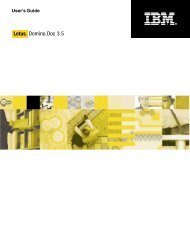Chapter 7 Working with Domino.Doc from a Browser - Lotus ...
Chapter 7 Working with Domino.Doc from a Browser - Lotus ...
Chapter 7 Working with Domino.Doc from a Browser - Lotus ...
Create successful ePaper yourself
Turn your PDF publications into a flip-book with our unique Google optimized e-Paper software.
More search notes (Profile-based and Full-text)<br />
• When you do profile-based searching and enter more than one criteria,<br />
the search engine interprets that as “find me all the documents that<br />
contain ’term A’ and ’term B’ in the profile fields as I have entered<br />
them.” For example, if you entered the term “National” in the <strong>Doc</strong>ument<br />
Title field and “Motion” in the <strong>Doc</strong>ument Type field, you would only get<br />
back documents that contained both terms in their respective fields.<br />
• You can conduct combined searches by entering profile-based terms and<br />
by entering terms in the full-text window during the same search. As<br />
mentioned above, the same idea applies, you are “anding” the search<br />
terms together.<br />
• Changes made to documents and document profiles are not immediately<br />
available until the full-text index task runs. What this means is that if you<br />
make a change to a document and then try searching for the document<br />
based on a word you changed, you will not see that document appear<br />
(based solely on your changed word) until the full-text index task runs. It<br />
is usually set to run every 3 to 5 minutes.<br />
• All tabs contain a file type filter at the bottom of the Desktop Enabler<br />
Plus window. This allows you to filter the list of viewable documents.<br />
For example, if you set the filter to “*.*” you would see all documents,<br />
regardless of file extension. If you set the filter to “*.doc” you would<br />
only see MS Word documents.<br />
Notes query syntax rules<br />
• Wildcards — Use ? to match any single character in any position in a<br />
word. Use * to match zero-to-many characters in any position in a<br />
word. In profile fields, be sure to put the word in double quotes.<br />
• Hyphenated words — Use hyphenated words to find two-word pairs<br />
that are hyphenated, run together as a single word, or separated <strong>with</strong> a<br />
space.<br />
• Logical operators — Use logical operators to expand or restrict your<br />
search. The operators and their precedence are not (!), and (&), accrue<br />
(,), and or (|). You can use either the keyword or symbol.<br />
• Proximity operators — Use proximity operators to search for words<br />
that are close to each other. These operators require word, sentence,<br />
and paragraph breaks in a full-text index. The operators are near,<br />
sentence, and paragraph.<br />
198 <strong>Domino</strong>.<strong>Doc</strong> User Guide












